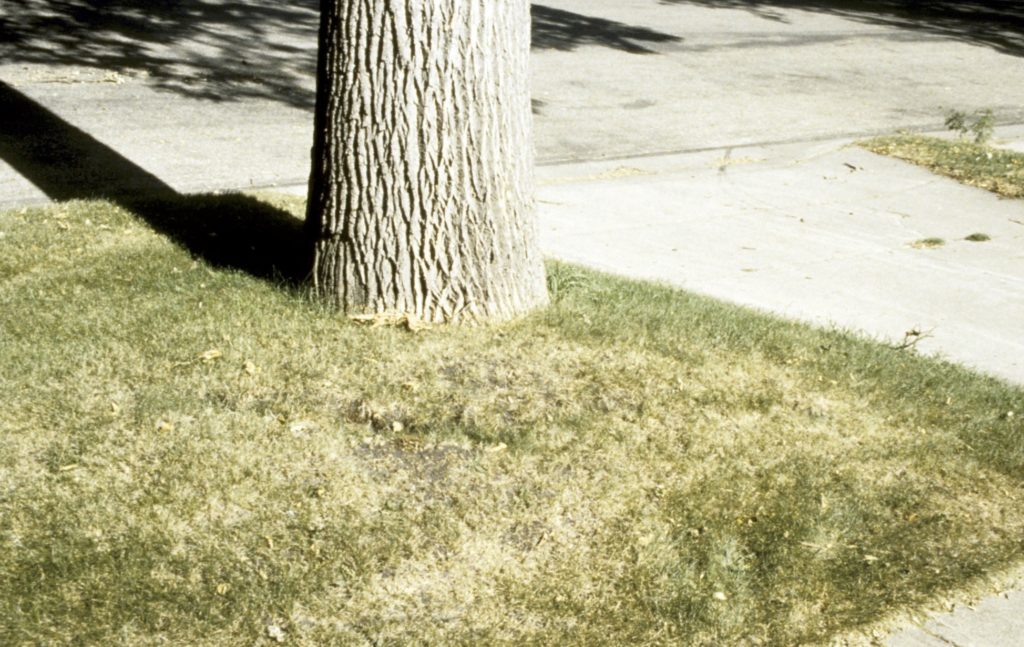
A tree planted among sidewalks, streets and other hardscape frequently cannot develop roots wide enough to hold it in place. (C) LawCain/DepositPhotos.com
I got suckered in by the title: “What’s Killing our Trees? The Top 5 Revealed.” Oh, good, I thought, an update on some of the pests threatening our precious trees.
But the talk was more about a threat few of us think about…homo sapiens and the things we do or don’t do to trees.
That was the message from Lindsey Purcell, urban forestry specialist at Purdue Extension’s Forestry and Natural Resources Department. Before Purdue, Purcell was Indianapolis’ city forester for eight years.
Purcell travels throughout the state working with cities, towns and others concerning programs, hazards and other tree issues. He said he gets about 6,000 phone calls and 3,000 emails a year seeking assistance with trees. He spoke at the annual Purdue Extension Marion County’s Spring Garden Clinic, attended by about 235 people in February.

Pay attention to how closely trees are planted to sidewalks and streets. Hardscape can limit root development. (C) Joseph O’Brien, USDA Forestry Services/Bugwood.org
Tree killer 1: Selection and placement
We fail to consider the mature size of a tree. That’s the height and width. We don’t know the type of soil in the planting area, especially the drainage. Dig the hole and fill it with water. If the water has drained in a day or less, that’s good, he said.
Along with location of utility lines, pay attention to how close the tree is to a sidewalk, driveway or similar surface. Remember that the trunk may only be a few inches diameter when you plant the tree, but at maturity, it will be several feet around.
Tree killer 2: Planting depth
Many trees are planted too deep. This is an absolute killer. Deciduous trees have what’s called a root flare, which is where the trunk turns into a root. In about the same area of the tree is the main order root. The main order root is important in determinating the planting depth of conifers, which usually don’t have a root flare.
The root flare and main order root should be right at or slightly above the soil surface. When planting trees from containers or balled-and-burlapped, scrape away the soil to reveal these elements. They may be 6 inches or more deep in the container or balled-and-burlapped. Check out Clemson University’s Show Me Your Root Flare!

Shave off portions of the root ball, especially when container grown, to get the roots developing properly. Photo courtesy Colorado State Unviersity Extension
Tree killer 3: Dysfunctional root system
Problems develop when container-grown trees with circling or binding roots are planted without correcting the problem. Using a tree saw or other serrated blade, shave off about 1 inch-thick layers from sides of the lower, one-half to one-third of the root ball, he said. Then, remove an inch from the bottom of the root ball. Removing these peripheral roots encourages those remaining and new ones that develop to reach out rather than in circles.

During construction projects, work with the contractor to protect trees and their root systems. Photo courtesy Vine and Branch, Carmel, Indiana
Tree killer 4: Construction impacts
This includes soil and root compaction and other damage, such as with new home construction or additions, earth moving equipment and construction materials and chemical dumping. Tree roots may be cut when building a driveway, sidewalk or other in-ground feature. Work with contractors to establish perimeters to protect established trees. Include these perimeters as part of your contract.
Tree killer 5: Improper pruning
Inexperience results in badly torn bark, leaving too much of a stump or cutting too close to the tree when trying to remove a large limb. Take the time to familiarize yourself with pruning methods. Start with Purdue’s Tree Pruning Essentials or Pruning Ornamental Trees and Shrubs . If you don’t think you can do the job, call a certified arborist.